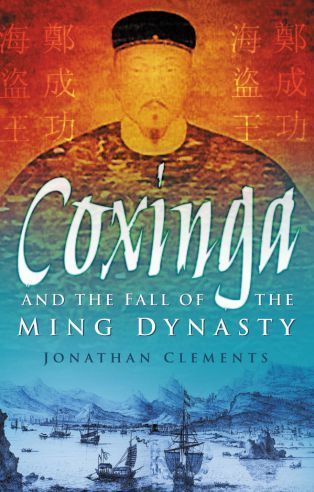Jonathan Clements's Blog, page 21
March 14, 2011
Salon Futura #7
 The new issue of Salon Futura is up online now, and features an article from me about Shotaro Ishinomori, Ken MacLeod on science fiction's uses in international relations, interviews with Ian McDonald and C.E. Murphy, and much much more. As a special bonus: your chance to see Starfish Hitler.
The new issue of Salon Futura is up online now, and features an article from me about Shotaro Ishinomori, Ken MacLeod on science fiction's uses in international relations, interviews with Ian McDonald and C.E. Murphy, and much much more. As a special bonus: your chance to see Starfish Hitler.
March 10, 2011
Kan Tokumaru 1941-2011
 I've written a short obituary of the voice actor Kan Tokumaru, over at the Manga UK hub.
I've written a short obituary of the voice actor Kan Tokumaru, over at the Manga UK hub.
March 5, 2011
It Takes A Village
 At the beginning of the 1990s, Shinichi Suzuki got an offer he couldn't refuse. Suzuki had been a Zelig-like figure in the history of anime and manga. He was one of the 1950s flatmates at the Tokiwa-so dormitory who ended up forming the nucleus of postwar manga, but he never really became a big-name manga artist. Instead, while his fellow creators dabbled in anime and largely retreated from it, Suzuki jumped in feet first, as an animator on Japan's first anime TV series for Otogi Pro, and then as one of the main men at Studio Zero.
At the beginning of the 1990s, Shinichi Suzuki got an offer he couldn't refuse. Suzuki had been a Zelig-like figure in the history of anime and manga. He was one of the 1950s flatmates at the Tokiwa-so dormitory who ended up forming the nucleus of postwar manga, but he never really became a big-name manga artist. Instead, while his fellow creators dabbled in anime and largely retreated from it, Suzuki jumped in feet first, as an animator on Japan's first anime TV series for Otogi Pro, and then as one of the main men at Studio Zero.
But Zero closed down in 1971, and Suzuki drifted from job to job, doing opening animations for kids' shows, or the animated bits on commercials for household appliances. As he faced retirement, it looked likely that his claim to fame would be as the inspiration for a ramen-loving character in Obake Q-taro, a series that nobody had heard of any more.
And then, out of nowhere, UNESCO came calling. Or rather, the Asia/Pacific Culture Centre for UNESCO, an educational body that needed a cartoon. Suzuki was thrown in a room with the Malaysian comic artist Mohammed Nor Khalid, a.k.a. Lat, and ordered to come up with a book that promoted literacy among adults. They needed to make it fun, and they needed to make it transnational, and the result was the illustrated book Mina Smiles, a very simple story comprising colour images with comic-style word balloons placed outside the text.
An eight-minute cartoon soon followed. It was paid for by a Tokyo insurance company, and involved Suzuki heading off to Kuala Lumpur to direct. He was shocked at the abilities of the Malay animation industry: already using computers in 1993. The story of the dark-haired dusky-skinned Mina, a married mother of five, was translated into a succession of languages in order to take its message to illiterate adults all over the third world, initially on VHS. When the DVD of Mina Smiles eventually came out in 2007, it contained a whopping 37 language tracks, including Mongol, Uzbek, Kiswahili, Wolof and Lao, not to mention Portuguese (for Mozambique) and Spanish (for everywhere else).
Mina soon returned in other books designed to teach remote communities about ecological issues: Mina's Village and Waste Management, Mina's Village and the Forest, and the later, longer animation productions: Mina's Village and the River and Mina's Village and Fire Prevention. The simple Mina comic has reached an audience of millions, and the cartoon that accompanied it might be, for some, the only cartoon they have ever seen. Mina is an international star to rival Pikachu, recognised in classrooms over half the planet, but unless you work for UNESCO or learned to read in the Vietnamese jungle, you have probably never heard of her.
Shinichi Suzuki came back to Japan to enjoy an active retirement as the curator of the Suginami Animation Museum, but when he sat down to write his memoirs, he didn't begin with his star-studded celebrity encounters with Tezuka or Mizoguchi. He started with Mina, who taught people how to read.
Jonathan Clements is the author of Schoolgirl Milky Crisis: Adventures in the Anime and Manga Trade. This article first appeared in NEO #81, 2011.
March 2, 2011
The 47 Ronin
 From A Brief History of the Samurai by Jonathan Clements, available now in the UK and US.
From A Brief History of the Samurai by Jonathan Clements, available now in the UK and US.
—-
The year of Mitsukuni's death saw one of the defining events of eighteenth-century Japan, the infamous vendetta of the 'Forty-Seven Rōnin'. As part of the endless rounds of ceremonial and courtesy calls of the Tokugawa period, Asano Naganori, the young feudal lord of the Akō domain was ordered to entertain envoys in Edo who had freshly arrived from Kyōto. As part of the preparations, he met Kira Yoshinaka, one of the Shōgun's high-ranking officials. The men do not appear to have hit it off, and, reading between the lines, Kira was expecting substantial bribes and honoraria from Asano, even though it was his job to instruct him. Whatever the nature of the tensions between them, Kira had mastered the art of the snide comment, and seems to have made one allusion too many about Asano's country origins. On 21 April 1701, under a covered walkway at one of the Shōgun's mansions, Kira pushed too far, and an enraged Asano drew his short sword and knifed him in the face (or shoulder, depending on the source).
The wound was minor and guards soon separated the brawling men, but the damage was done. Regardless of claims of the right of samurai to defend their honour, drawing a weapon within the Shōgun's palace was a capital offence. Asano was ordered to commit seppuku, his lands were forfeit, and his followers were outcasts – rōnin. When the news reached Asano's castellan Ōishi Yoshio, Ōishi obediently shut down the castle, disbanded the soldiers, and handed the keys and manifests to the new lord appointed by the Shōgunate. Where once there might have been war, the Tokugawa rule was supreme, and a lord could be unseated by simple decree.
However, while Ōishi had done his duty to the Shōgun by obeying orders, he was also determined to do his duty by the wronged lord Asano. In the company of several dozen fellow retainers (traditionally forty-seven, but possibly more), he plotted his revenge against Kira. Over the two years that followed, Ōishi gave every appearance of being a discredited samurai. He was seen in Kyōto brothels, he was publicly drunk, and he was conspicuously on the Tokugawa-era scrapheap. In a move that has often been cited as an indicator of his true nobility, he even divorced his wife and disowned his children, to ensure that they would not have to bear any consequences for his coming vendetta.
Slowly, the Forty-Seven Rōnin converged on Edo. One married the daughter of the man who had built Kira's house, obtaining in the process the plans for the inside of the mansion. Others secretly smuggled weapons into Edo. The vengeful assassins struck on 14 December 1702, in a double-pronged assault on Kira's snow-bound house.
The mansion erupted in a savage battle between Ōishi's men and Kira's underlings, which saw sixteen of Kira's men killed and another twenty-two wounded. Kira, however, had fled through a secret exit, leaving his bedclothes still warm. Ōishi bested two other retainers in a dark, secluded courtyard, before dragging the man they were protecting into the light. Beneath the warm glow of the lantern, Ōishi saw the scar left by his master's knife. He had his man.
In one of the strange turnabouts of the samurai world, Ōishi dropped to his knees and bowed before Kira, explaining who he was and humbly offering him the chance to atone for his misdeeds by committing suicide. It was only when the cowering Kira refused to respond that Ōishi dragged him up by his hair, and hacked off his head. Their job done, the samurai carefully extinguished the lamps in the house in order to avoid accidental arson, and then ran for Asano's grave with Kira's head.
As the sun rose, word spread of their action, and they made their way to the temple grounds of Sengakuji amid something of a carnival atmosphere, congratulated and fêted by the townsfolk. They laid Kira's head on Asano's grave, and then turned themselves in to the authorities – all except one, who had been sent to Asano's old domain to pass on the news.
The vendetta was an awful embarrassment for the Shōgun's government – the samurai had behaved impeccably according to samurai tradition, but had also defied a Shōgunal prohibition. Edo locals did not help by petitioning the Shōgun on behalf of Ōishi and his men, pointing out how true they were to the nebulously defined samurai code of honour. Eventually, the Shōgun ordered that instead of the death penalty as common murderers, the rōnin would be offered the chance to commit seppuku as a gesture of respect. This they did in early 1703, with the exception of the messenger in Akō, who was spared. Their act cleared the name of their late lord, restored the reputation of their many fellow retainers, and eventually led to the restoration of the house of Asano, albeit with a greatly reduced size of fief.
The men were held up as heroes by many, although one noted commentator gruffly wondered how 'true to tradition' it would have been if their target had died of an illness during the prolonged execution of their two-year plan. Instead, one samurai theorist suggested that the true samurai way would have been to attack Kira on the day of the original insult. They would still have died, but the process would have been quicker and more conspicuous. Such a comment, made by Yamamoto Tsunetomo, encapsulates the contradictions of the samurai era. Taken at face value, there often seems little difference between a samurai dispute over honour and a fight in a pub between football hooligans over who has the nicest scarf.
A Brief History of the Samurai, by Jonathan Clements is available now in the UK and US. The film 47 Rōnin, starring Keanu Reeves and Hideyuki Sanada , will be released in December 2012.
March 1, 2011
Cultural Capital
 I'm intrigued by the latest book from Toshio Okada, self styled king of the otaku and undeniable media studies guru. Sadly, only known in English for the persuasive fanboy diet book Sayonara Mr Fatty, although anime fans will be well aware of his immense contribution to the medium, both as a producer and critic. His Introduction to Otakuology remains a vital book for understanding the growth of the fan market in Japan in the 20th century; his Testament is a densely-packed info-dump of anime industry gossip. And now, Amazon Japan wastes no time in letting me know that he's brought out yet another book on a fascinating subject: The Valuation Economic Society — I'm still wrestling with the correct translation for Hyouka Keizai Shakai, because "hyouka" is valuation, but also criticism and even review.
I'm intrigued by the latest book from Toshio Okada, self styled king of the otaku and undeniable media studies guru. Sadly, only known in English for the persuasive fanboy diet book Sayonara Mr Fatty, although anime fans will be well aware of his immense contribution to the medium, both as a producer and critic. His Introduction to Otakuology remains a vital book for understanding the growth of the fan market in Japan in the 20th century; his Testament is a densely-packed info-dump of anime industry gossip. And now, Amazon Japan wastes no time in letting me know that he's brought out yet another book on a fascinating subject: The Valuation Economic Society — I'm still wrestling with the correct translation for Hyouka Keizai Shakai, because "hyouka" is valuation, but also criticism and even review.
The book blurb explains it better: "Moving from a 'Money' Society to a 'Value' Society"… okay, well maybe the other book blurb explains it better: "If you've got a million followers on Twitter, it's easy to make a hundred million yen. But if all you've got is a hundred million yen, it's hard to get a million followers on Twitter."
February 24, 2011
Grand Theft Anime
 When we meet, it's at a place of his choosing, one of those odious, pokey little Roppongi bars where women pretend to like you for a fee. Saotome smirks in the corner by a bottle of whisky that literally has his name on it – they keep it behind the counter for him – and with a girl in a slinky red dress who oohs and aahs at his every word.
When we meet, it's at a place of his choosing, one of those odious, pokey little Roppongi bars where women pretend to like you for a fee. Saotome smirks in the corner by a bottle of whisky that literally has his name on it – they keep it behind the counter for him – and with a girl in a slinky red dress who oohs and aahs at his every word.
The Japanese like to present themselves as benevolent creatives who sit around all day thinking of cool stuff. They love fans, of course, although not for the reasons you would think. The love fans because they'll buy any old crap.
"I bet you think I was part of the Cel Cemetery Scandal?" he says, an eyebrow raised in suspicion.
I confess that, yes, I'd figured that one had his fingerprints all over it. It's a story that everyone in the anime business tries to forget. Back in the 1990s, when anime were still assembled on acetate cels, new environmental laws forced Tokyo studios to pay extra money for ecologically sound disposal. Old cels had a high chemical content; they needed special treatment, and that meant paying extra fees to the garbage men.
One well-known studio decided to save some money, even at the expense of not saving the world. They waited until nobody was looking, dug a pit in their backyard, and buried all the cels. Piles after pile of Schoolgirl Milky Crisis images, shovelled underground and forgotten.
"Now," says Saotome. "You tell me. How do you know that wasn't me?"
I gingerly admit I still thought it was him.
"That case only came to light for one reason," he says. "It was the damn fans. Police caught fans breaking into the studio and digging up the back yard so they could steal the cels! They were collectors! They could wipe the dirt off and sell them for a few bucks. If I'd been in charge, I'd have been sending the interns down to conventions with truckloads of the damn things. I wouldn't hide them! I'd sell them!"
"And then," he admits after a sip of his whisky. "The ones I couldn't sell, maybe I'd throw those in a landfill somewhere."
Saotome is always working the angles. He's an asshole, but he is still an anime classic. He's a legend.
"Saotome's my friend," one producer told me. "He's always been there for me when I needed him. But when you shake his hand in business, count your fingers afterwards."
Saotome came into the anime world through contracts and legal – he was renowned for knowing his way around corporate law. Most infamous was the way he handled himself at the collapse of a well-known studio. Just a few signatures, your name here, and here, and… here, and he'd managed to get a famous creator to sign over the copyright in three of his latest ideas.
When Saotome saw the writing was on the wall, he sent in his minions to grab anything that wasn't nailed down. Before the bailiffs could arrive to shut down the studio, Saotome was backing up a truck. He took the filing cabinets, he took the post-its, he took anything that wasn't nailed down. And two streets over, he opened up a new studio. His studio.
He'd already set up a new company under a different name, and planned on selling cartoons based on the intellectual property he'd just stolen. Nor did things stop at the titles themselves. Those shows were drawn with pencils, inked with acrylics, and shot on a rostrum camera stolen from Saotome's former workplace.
"Don't look at me like that," smirks Saotome over his whisky. "You kids who play everything by the book, you know what would have happened?"
I shrug.
"Nothing!" he shouts, banging his hand on the table and attracting scowls from fellow drinkers. "The law suit over that dead studio lasted for twelve years. Anything that wasn't stolen was locked up till then while the lawyers argued. You think a marker pen's good after 12 years? You think the paints were still useable? We liberated that stuff, my friend. We liberated it."
Saotome doesn't see himself as a burglar. He sees himself as the man who got three shows made that might never have happened. In his own little world, he's a hero, and perhaps he's right. He's made a lot of blunders in his life, but he's always been ready to get to his feet and try again.
Look on the credit lists of some of the most famous shows, and you'll see Saotome's name. He was there in the sci-fi boom, when Star Wars made space popular again. The same company, its name changed, was at the forefront of the tits-and-tentacles fad. In the 1990s, he'd been going through the old paperwork when he realised that the wording in an old contract implied he had part ownership of a famous sci-fi franchise. He didn't hang around – he commissioned a remake and dared the real creator to sue.
To some people, Saotome is a role model, even – there are half a dozen producers who are reading this now and wondering if it is about them. There are animators who owe their livelihoods to him. Saotome sees himself as an optimist. That's what management does, it optimises. It thinks of what's possible and goes for it. But Saotome has a respect for the Law. It's what he trained in.
"I've never committed a crime," he says. "People call me a criminal, but all I did was look for loopholes in things that were already there."
His pretty companion whispers something in his ear.
"Oh, right," he says. "I didn't commit any crimes in the animation world. Obviously, that thing with the guns and the cannabis, that was different."
Jonathan Clements is the author of Schoolgirl Milky Crisis: Adventures in the Anime and Manga Trade. This article first appeared in PiQ magazine #2, May 2008.
February 19, 2011
Fallen Angels and Chronokids
 And that's me back from what used to be known as Screen Academy Wales, but is now called Media Academy Wales — am I the only person who thinks that sounds considerably less cool? This was probably my last storylining workshop of 2011, for BA and MA students in film, video, and games from several Welsh colleges.
And that's me back from what used to be known as Screen Academy Wales, but is now called Media Academy Wales — am I the only person who thinks that sounds considerably less cool? This was probably my last storylining workshop of 2011, for BA and MA students in film, video, and games from several Welsh colleges.
As ever, I began by ranting at them about odd ideas, rules and techniques in the animation business. As ever, the students didn't disappoint, pitching two series ideas that they were forced to wrench into existence in less than two hours.
In Chronokids, modern day children develop the ability to travel in time, and an awareness that thieves are looting Earth from the future. Meanwhile, for Fallen Angel, another group pitched a class-aware eco-drama set in a drowned New York, where a poor little rich girl falls from one of skyscrapers that still stick out of the sea, and is adopted by kindly mutant fish-folk engaged in a war against toxic dumping.
These pitches join other great ideas like Choc Shock, Hattie Bast: Mummy's Girl, Decontaminators and Waxing Moon, all of which have been whipped up out of nothing by students on previous workshops. I'm not saying it's easy, but sometimes the students seem surprised by how their own brainstorming can create something that can give real TV shows a run for their money. And that's the idea of the storylining workshop: simply to give people the confidence to know that they should never be afraid of a blank piece of paper, or indeed of saying a dumb idea. As ever, the "dumb" ideas turned out to be the ones that made it to centre stage.
What was different about this session was that some of the students suggested that they might even take one of the ideas and develop it further as part of their course work. Well, why the hell not? If something comes of it somewhere down the line, that would be a Saturday morning in Cardiff well-spent.
February 14, 2011
Salon Futura #6
 The latest issue of Salon Futura is now up online, with a special Valentine's Day theme in which I contribute the article "1778 Ways to Say I Love You", about the Japanese science fiction author Taku Mayumura.
The latest issue of Salon Futura is now up online, with a special Valentine's Day theme in which I contribute the article "1778 Ways to Say I Love You", about the Japanese science fiction author Taku Mayumura.
Meanwhile, I staggered back into London at dawn this morning on the sleeper from Glasgow, where yesterday's storylining workshop produced the utterly bonkers Waxing Moon – the tale of a family of werewolves (plus one hapless were-iguana), whose tanning and waxing salon is under threat from business rivals at a vampire hat shop. The end result was a sort of supernatural pastiche of the Brady Bunch, with a werewolf and a vampire girl falling in love while rehearsing the school play Romeo & Juliet in which the Romeo and the Juliet genuinely do come from two contending aristocratic houses. It is a shame that we shall never see a real-life TV show in which orange-skinned vampires dominate at the high-school fencing club, or where the super-cool, super-vain vampire elder brother is a boy called Gary, who glitters. With a music teacher called Shump Jarking.
As with earlier incarnations at the Irish Film Institute and Screen Academy Wales, it's always fascinating to see the shows that people come up with when they are given the rules that professional writers have to follow. Waxing Moon joins Decontaminators, Hattie Bast: Mummy's Girl and Choc Shock among the alternate-world TV show ideas that have come up in a couple of years of the storylining workshop. What made Waxing Moon different and rather precious is that the storyliners were all teenagers themselves.
February 11, 2011
The Disappearance of Jonathan Clements
 Off to get the train to Scotland for tomorrow's Anime Day at the Glasgow Film Theatre, which includes King of Thorn, Eureka Seven: The Movie, and The Disappearance of Haruhi Suzumiya. I shall be introducing all three films, and talking onstage to Kaze Animation's Andrew Partridge about surfing, Trainspotting, and issues in modern anime. I expect it will turn into Ten Things That Are Funny About Shintaro Ishihara and the Fractale Production Committee, but we'll see how it goes.
Off to get the train to Scotland for tomorrow's Anime Day at the Glasgow Film Theatre, which includes King of Thorn, Eureka Seven: The Movie, and The Disappearance of Haruhi Suzumiya. I shall be introducing all three films, and talking onstage to Kaze Animation's Andrew Partridge about surfing, Trainspotting, and issues in modern anime. I expect it will turn into Ten Things That Are Funny About Shintaro Ishihara and the Fractale Production Committee, but we'll see how it goes.
February 8, 2011
An Unhappy New Year
 From Coxinga and the Fall of the Ming Dynasty, by Jonathan Clements, available in the UK and US.
From Coxinga and the Fall of the Ming Dynasty, by Jonathan Clements, available in the UK and US.
____
On 8 February 1644, the first day of the Chinese New Year, the ministers of the Emperor of Lofty Omens woke before dawn and journeyed through the streets of Beijing. At the break of day, in keeping with tradition that stretched back for centuries, they would greet their 33-year-old ruler, whom the gods had selected to reign over the entire world. Then, the assembled throng would welcome in the new year, the 4341st since China's first, legendary kings, and entreat the gods and ancestors to bring them good fortune.
The city, however, was quiet. Many of its inhabitants had succumbed to a harsh outbreak of disease the previous year, and according to one diarist, 'no babies had been born in the city for the previous six months.' Not all the ministers arrived at the palace on time. Those that did found the gates jammed shut, and were only able to open them with some difficulty. Eventually, they found the Emperor of Lofty Omens, in the Hall of the Central Ultimate. He was weeping
China was doomed. The Dynasty of Brightness, the Ming, which had ruled the world's largest nation for centuries, had lost its hold on power. A Confucian scholar would have been scandalised at the low attendance that morning; without a full complement of ministers, how could they perform the necessary ceremonies? But not even the Emperor himself bore a grudge against the absentees, or those who arrived late, wheezing breathless apologies. No amount of prayers and ceremony would change the inevitable, and no sacrifice, however elaborate, would attract the ancestors' attention from the afterlife.
Besides, the Emperor could not afford it. Ever since the disastrous reign of his father, the nation's budgets had spiralled wildly out of control. Attempts to curtail imperial luxuries were not enough, fundamental cornerstones of civilization had gone to ruin. The Grand Canal to the south was falling into disrepair, and the postal system had been shut down. Smallpox had wrought havoc among the farming communities, who struggled in vain to tease crops from the earth – though few realised at the time, the middle of the 17th century gripped the world in a mini-ice age. The same weather conditions that were then freezing over the Thames in London were also bringing deadly cold to the lands north of the Great Wall.
The Emperor was fated to fall. While the Great Wall still held, a new enemy struck from within. Starved of food and decimated by disease, a distant inland province rose up in revolt. An army of disaffected soldiers and peasants, began to march on the capital city, led by the rebel Li Zicheng.
Li Zicheng, formerly one of the post-riders who delivered mail along China's once-great roads, had been obsessed with seizing control of the Empire from his youth. Not even losing an eye in battle dimmed his ardour, as one old prophecy had predicted the Empire would fall to a man with only one eye. His previous dealings with other members of the imperial family had been less than favourable. During his campaigns, he not only killed the Emperor's uncle the Prince of Fu, but drank his blood, mixing it into his venison broth. Li Zicheng was the leader of a horde of almost 100,000 soldiers, boiling across the country towards Beijing, gathering still greater numbers as peasants flocked to its tax-free banners.
On New Year's Day, as the Ming Emperor sat sobbing in his palace, Li Zicheng announced his intention to found a new dynasty. The Dynasty of Brightness, he said, had fallen. Long live the Da Shun, the Dynasty of Great Obedience.
With the usurper Li Zicheng advancing ever closer to Beijing, the Emperor of Lofty Omens knew it was time for drastic measures. Drunk and disoriented, he ordered for the Ming Heir Apparent to be smuggled out of the city. He gathered the rest of his family about him and informed them that it was time to die. Some of his wives and concubines had already committed suicide, and were found hanged or poisoned in their chambers. Others had fled. There was no such option for the immediate family of the Emperor, who attacked his own children with a sword. The 15-year-old Princess Imperial held out her right arm to stay his attack, and the Emperor hacked it off. The maimed girl fled screaming through the halls, leaving a trail of blood. Her younger sisters were not so lucky, and both died where they stood, stabbed by their own father. The Emperor then went to a nearby hilltop, where he wrote a final message in his own blood, before hanging himself as Li Zicheng's army drew closer. Later writers would claim the Emperor's last words blamed his ministers and his own 'small virtue' for the collapse of the Ming Dynasty, and exhorted the rebels to spare his people from suffering. In fact, the Emperor's bleeding finger simply traced the plaintive, spidery characters 'Son of Heaven.' His body lay undiscovered for three days.
Jonathan Clements's Blog
- Jonathan Clements's profile
- 123 followers



